Two weeks from today I will be in the home stretch as the final process for executing the HO Studley Tool Cabinet and Workbench Exhibit (there are still tickets remaining here) begins at the Scottish Rite Temple of Cedar Rapids, Iowa, only twenty minutes away from the hand tool nirvana of Handworks. The list of things “To Do” in preparation for the exhibit is getting shorter. Off the top of my head this is the status report of what I’ve been doing over the past two years (there are undoubtedly many other components I am not remembering at the moment):
Exhibit locations and spaces scouted and evaluated – done
Exhibit space reserved – done
exhibit $pace paid for – done
exhibit graphics (wall panels, banners) selected and edited – done
exhibit graphics sent to production company – done
exhibit graphics in production – check
exhibit graphics paid for – no invoice yet
Studley collection apprai$ed – done
Studley collection appraiSal paid for – done
exhibit in$urance arranged – done
exhibit in$urance paid – done
exhibit casework designed and submitted to fabricators – done
exhibit ca$ework paid for – done
exhibit plexiglass locking vitrine designed and sent to fabricator – done
exhibit locking vitrine fabricated – done
exhibit locking vitrine fabrication paid – no invoice yet
Studley collection high securitydedicated transport locked in – check
Studley collection high security and dedicated transport paid – invoiced after the exhibit
exhibit didactics designed and fabricated – 90% there
Studley workbench replica fabricated – done
custom fitted dollie for Studley workbench base – fabricated
exhibit theatrical backdrop$ and lighting secured – scheduled
exhibit theatrical backdrops and lighting paid for – no invoice yet
exhibit tickets designed (different designs for each day) – done
exhibit ticket$ printed and paid for – done
exhibit installation crew recruited – done
exhibit docents recruited – done
book manuscript proofs sent to docents – done
exhibit deinstallation crew recruited – done
packing everything I need to take with me – NOT done (yet)
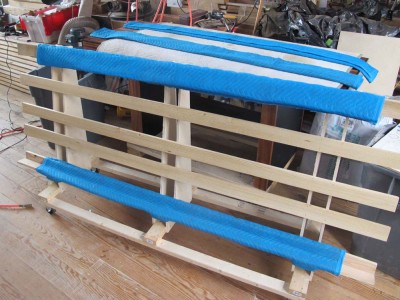
Today I am wrapping up the last “big” thing, which is to finish applying the padding to the “A” frame style cart on which I can secure the exquisite mahogany-over-oak bench top from the original Studley workbench.
After this it is just a matter of wrapping up a multitude little things, getting packed, and then heading towards Cedar Rapids for the opening on May 15.
I hope to see you there.
Yesterday was a gorgeous cool spring day, and I was comfortable enough with the progress in preparing for the Studley exhibit that I took 90 minutes to to make some repairs to the hydro power waterline and get it up and running after a fashion. We are not expecting any more hard freezes here, although there is the expectation for some snow flurries tonight and probably a couple more weeks of frost concerns for the garden, so the time was auspicious for the reactivation of the system that had been down since it froze solid in mid-November.
Once I get recovered from the exhibit I will tie it all back together (the top 300 feet of pipe is not yet attached and the intake now is simply laying in a trough at the bottom of the stream, with a head of about 100 feet) to maximize the power output, although I don’t really even need the power right now since I am not doing much in the way of electricity intensive work. But next month I will be building the prototypes for the workbench build in September, and that will require some wattage.
For now, I have the system running and the soft whine of the turbine is just barely audible above the vigorous flow of water running by.
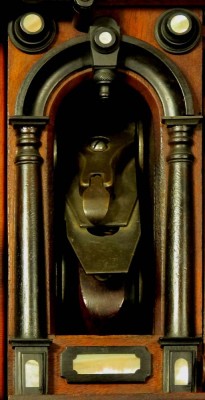
One of my many goals for the upcoming exhibit of the Henry Studley collection is to give the visitor a real sense of the details Studley lavished on his tool cabinet and workbench, including many that are hidden from view but some of which are almost “front and center.” Among these prominent features is the arch and alcove, used as the home for his Stanley #1 plane, perhaps the only instance of this model I had ever seen with honest to goodness wear. Thanks to the permission of the owner and equipped with silicone molding rubber putty I was able to get impressions of the top half of the arch.

Once I returned home to begin the process of making castings from this mold I realized how inadequate my mold was and set out the create a maquette, or master wax model, from which I could make a second mold, and from that second mold cast replicas for the viewer’s interaction.

The mold that I had made was okay, as far as it goes, but it was not as complete as I needed for making three-dimension replicas. To resolve that, I decided to embed the entire mold in a block of molten wax, then carve away the excess and essentially sculpt the maquette from the remains.
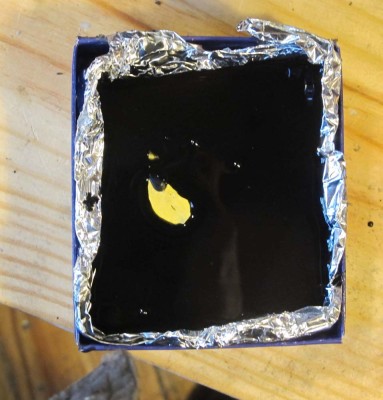
I found a cardboard box a little larger than the original mold and lined it with aluminum foil, then filled it with enough pigmented wax to cover all the parts I wanted to work on. I pigmented the wax just so it was easier for my tired old eyes to work it.
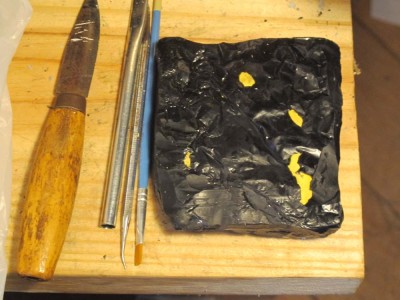
Using common bench tools, mostly chip carving knives, I whittled away all the waste to get to the material left in and around the original mold. The resulting wax casting was perfect for sculpting the maquette, so I did.
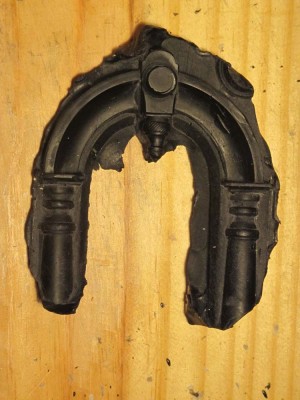
Next time – casting the replica for display.
I realize with no small element of chagrin that between all the activities drawing on my time, energy, and concentration, I have been remiss in carrying forward the Shellac Archive (it seems as though I have posted only 10 of the documents from my collection, which at least volumetrically, leaves more than 95% to go). I will soon strive to make its nurturing a regular part of the Blog. My personal archive has now taken up residence with us in the mountains, so I can resume the scanning and editing of it for dissemination to you.
This reality was struck home to me this week as I was trying to find a particular picture I needed as I near the finish line for the upcoming HO Studley exhibit. As is my wont when I am weary, I just let my mind wander, and in concert with that began to browse the voluminous folders of images on my compewder. While doing so I ran across several hundred pictures I had taken many years ago, recording the pages of long forgotten academic theses from one of the nation’s great universities.
The titles are self explanatory, but the depth and breadth of the contents are not.
The Manufacture of Shellac Paint
Deterioration of Bleached Shellac With Age
Dewaxing of Shellac
Deterioration of Bleached Shellac With Age (different than the previous listing)
Some Studies on the Effect of Storage on Shellac
Plasticization of Shellac
A Study of the Methods for Determining the Properties of Shellac
A Study of the Solubility of T.N. Shellac in Aqueous Sodium Carbonate Solutions
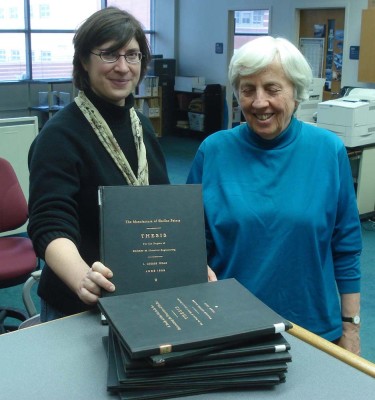
I will post these theses, but not until tell you the amazing tale of how they came into my possession, thanks to the conscientious generosity of two determined archivists. It is a tale of worldwide fascist ambitions, flourishing scholarship in an unlikely time (ultimately abandoned and discarded), and finally the overcoming of a pronounced phobia to reclaim them.
Stay tuned.
You might be getting tired of HO Studley posts, but it is all I am working o these days so it’s pretty much all I have to talk about. It will all be over soon.
On my final visit to the Studley tool cabinet last October, with the owner’s permission I made a number of silicone rubber molds from the details Studley created and integrated into his masterpiece. My access to the elements was not perfect, it was an intact artifact hanging on the wall after all, so I chose two part silicone molding putty from Hobby Lobby. In the past I have used food grade molding putty by the bucketful, but for this project I needed just a bit and the hobby store package was just fine.
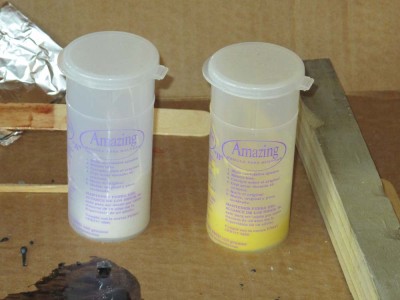
Using it is simple, just take equal parts of the two putties and knead them together until the color is uniform. Then, in the next 15-20 seconds press the wad against the surface you are trying to mold, sit back, and remove a finished and cured mold in a few minutes.

Given the spatial logistics of taking impressions from the tool cabinet, the molds were not perfect but they were useful. Once I got into the swing of producing the elements for the exhibit “The Henry O. Studley Tool Cabinet and Workbench” (tickets still available) I made some first generation beeswax castings from those molds just to see what was needed to come up with something exhibit worthy.

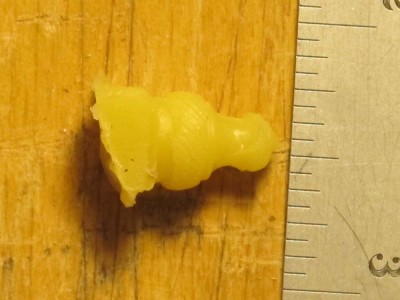
It’s fair to say that all of the castings in the upcoming exhibit were the result of several generations of molds and castings, with many hours spent in refining the representations of the elements under the microscope. On a project with more available time I might spend a week per element, but in this case I was lucky to carve out a day per element.
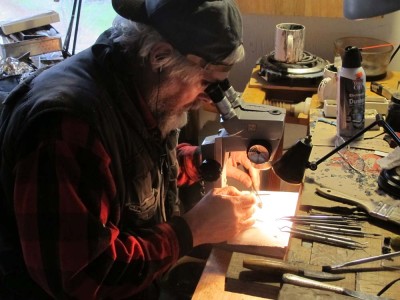
Much like picture from the Mars Rover, the whole is often a composite assembled from the disparate pieces. Even so, these are not perfect but they will allow the exhibit visitors to get a better sense of what Studley made to embellish his masterpiece.
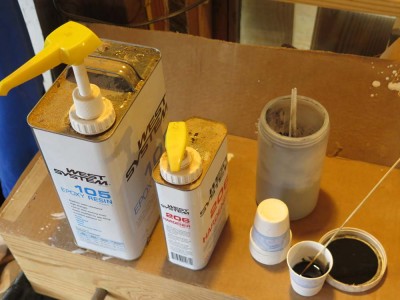
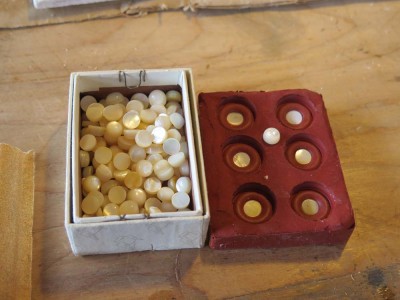
In the end, using the molds for casting some pigmented West System epoxy and some mother-of-pearl I got results that will convey the grandeur of these elements up-close-and-personal for the exhibit patrons as this panel will be sitting on the replica workbench for touching and examining closely.

As time allows I will detail the process of refining specific elements, with observations about both moldmaking and casting materials useful to the decorative artisan.
I’ve been a reader of Popular Woodworking for several years, and in recent times have enjoyed a very congenial working relationship with them. I just got the latest PW Issue 218, which is a terrific and not just because I have two things in it. There are several great articles including the cover project and a long insert.
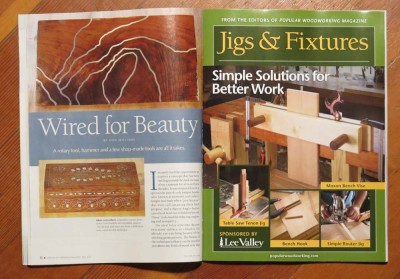
The magazine features my article on decorative wire inlay (bisected by the aforementioned insert) and the End Grain column about the Studley Tool Cabinet that ran on the Popular Woodworking web site a few days ago.
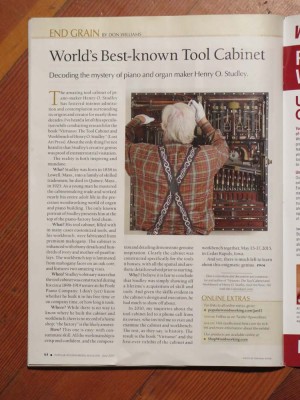
Mrs. Barn glanced through the issue and said, “Very nice article. (I think she was talking about the Studley piece — DCW) But when are you going to start making furniture for me?”
Ouch. I guess I know what I’m doing after the Studley exhibit.
Integral to the in-production book Virtuoso and the upcoming exhibit on the same topic, I am striving to make it more than just a tool peepshow. You are gonna learn something even if you do not want to!
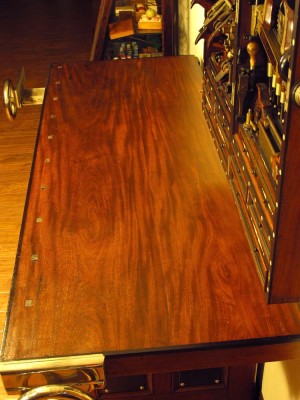
Part of that learning experience will be the exposure to the remarkable Studley workbench and vises (above), including a display of similar contemporaneous vises that have been loaned for the exhibit.

To carry the weight of these six vises (somewhere in the neighborhood of 500 pounds) I built a fairly faithful replica workbench top, sitting on a base made for the exhibit but which will be swapped out for a cabinet base at some point.
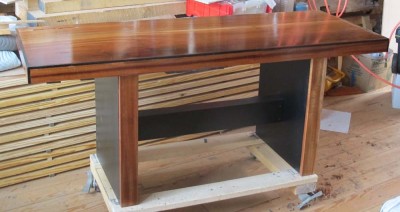
About the only semi-tricky part of the bench build was dropping the end vise dog slot with my 3-1/2 hp plunge router, the only power tool that makes me nervous.
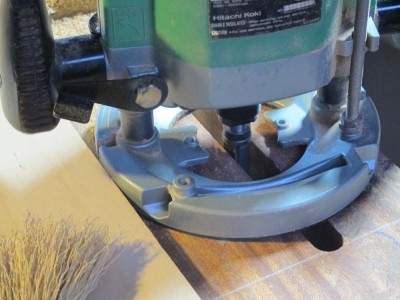
With multiple measurements and confirmations, I cut the channel from above and below, and the vise and its dog yoke dropped into place cleanly.
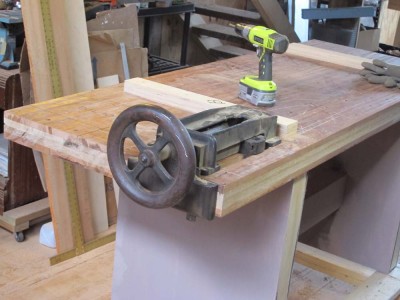
Now I can put the router beast away until I need it again in several more years.

To increase the didactic function I left the front edge of the replica bench unfinished so you can see the core construction. As soon as the unit is back home the already-constructed front edge will be installed. Another thing to occur after the exhibit will be to dispense with the glossy finish applied for the display (four coats of Tru-Oil, then buffed) through the vigorous use of a toothing plane to leave the surface I prefer.

I don’t have any pictures of the finished bench with all the vises on it. I mounted them when it was upside down, but could not budge it to flip it right side up until I had removed all the vises. So, you will just have to wait on that visual for the exhibit itself.

photo courtesy of Narayan Nayar
It might be the fact that I am in the midst of what could be called Studley Silly Season, wherein my time and energies are focused entirely on getting the exhibit of the Henry O. Studley Tool Cabinet and Workbench done and over, but it seems that I see everything in the light of what old Henry had in his tool cabinet. One of his tools was this set of ultra precise measuring calipers (above).
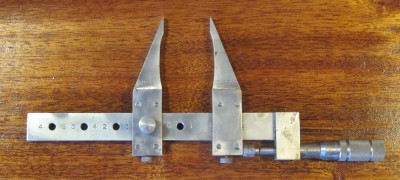
Consider this intriguing micrometer I found in a vintage tool store in Connecticut a couple of years ago, and which I have found a useful addition to my tool kit. While it is functionally similar to the Starret vernier micrometer Studley had stashed back in his tool cabinet, this one is a more straightforward micrometer system mounted on a movable bar.
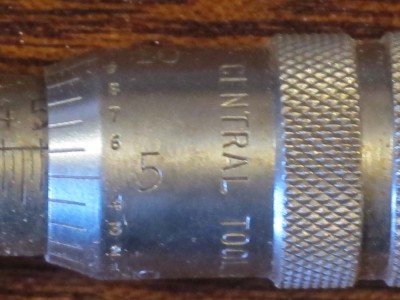
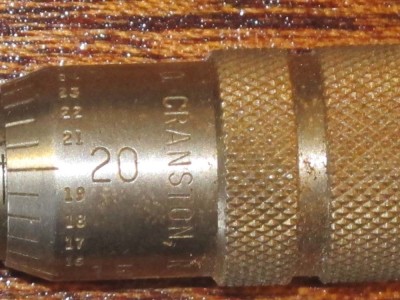
Made in Cranston RI at the Central Tool Co., this is unlike anything I had ever seen before, notwithstanding my years in a foundry/machine shop.
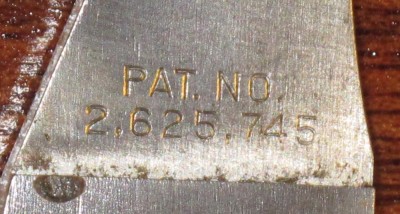
Just something for amusing contemplation on a beautiful spring evening.
Probably the simplest beautiful finish from a technological point of view is the French molten wax polish, which has but a few individual components yet yeilds a beautiful, lustrous presentation surface.
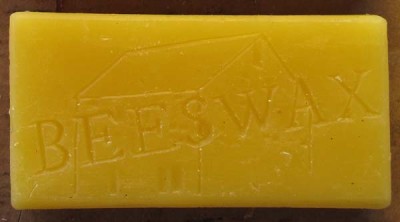
The first thing is a block of clean beeswax. I render my own from raw wax straight from the beekeepers after the honey is harvested.
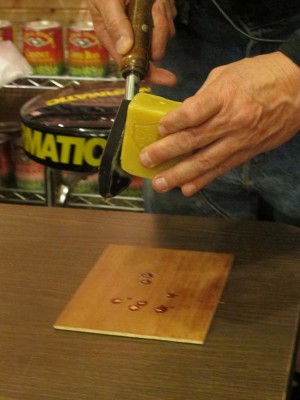
Next comes a source of heat to melt the wax onto the surface of the wood. Historically something like a roofer’s soldering iron was used, these days I use an electric tacking iron.
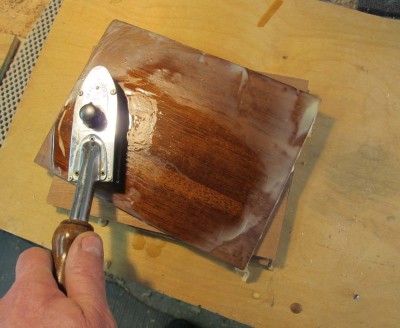
I move the hot iron over the surface, spreading and melting the wax onto and into the surface until it is fully saturated.
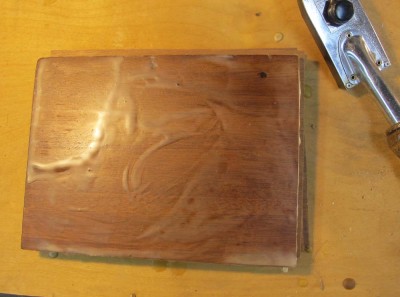
Once the molten wax has been imbibed fully into the wood surface it is left to cool,

and once fully hardened it is scraped with a simple metal, wood, or bone scraper. If the scraper has a nice clean edge (no burr!), the resulting surface can be mirror-like. A little buffing with a piece of soft cloth like worn flannel or fine wool and you are done. This might even be enhanced with some spit polish.
The result is a high-sheen, non-toxic and easily repairable surface that is pretty robust against abrasion but utterly defenseless against heat or oily materials. I’m working on some formulations to make this finish a lot tougher, but it is increasingly one with which I am toying, and as I move forward with designing and fabrication parquetry panels, you can believe it is something I will employ.
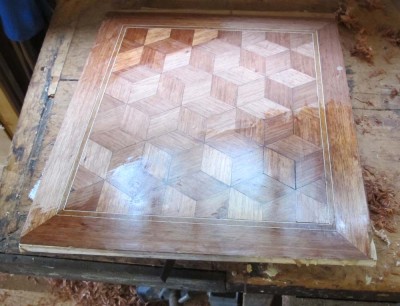
My Team Studley compatriot and project photographer Narayan Nayar tells the tale of preparing hundreds of images for the book, which incidentally is about halfway through production. It is scheduled to be released the day before I start the installation of the Studley Tool Cabinet and Workbench Exhibit on May 13.
Am working on getting the exhibit finished all day, every day.
DCW






































Recent Comments